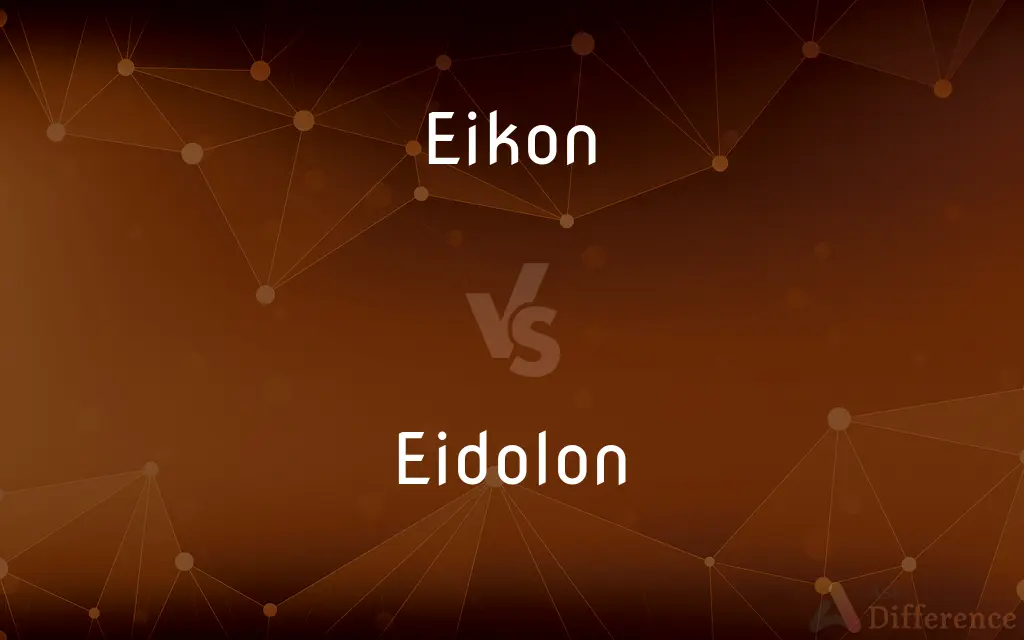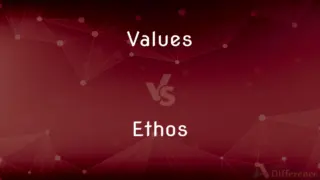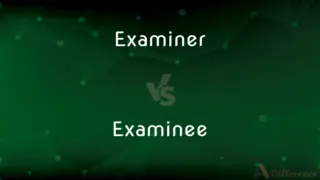Eikon vs. Eidolon — What's the Difference?
By Tayyaba Rehman & Urooj Arif — Updated on May 2, 2024
Eikon refers to a holy image or representation in Eastern Orthodox Christianity, often venerated; eidolon generally denotes a phantom or an idealized form, used more broadly in literary contexts.

Difference Between Eikon and Eidolon
Table of Contents
ADVERTISEMENT
Key Differences
Eikon is a term used primarily in Eastern Orthodox Christianity to describe a religious icon that is venerated and considered a sacred representation of the divine. Whereas eidolon, derived from Greek, typically refers to a phantom, specter, or an ideal form, often used in literature to convey concepts of idealism or illusion.
In religious contexts, an eikon is an object of devotion and a focal point for prayer, believed to be imbued with spiritual significance and the presence of the divine. On the other hand, eidolon in mythology and spiritual beliefs represents an insubstantial image or a ghostly apparition, lacking the concrete and revered status of an eikon.
Eikon involves specific iconography and symbolism in its creation, adhering to strict religious guidelines and traditions in its portrayal of saints and divine figures. In contrast, eidolon is used more flexibly in the arts, particularly in poetry and visual arts, to depict abstract concepts or unreal visions without the constraints of religious orthodoxy.
The concept of eikon can be discussed in terms of its role as a bridge between the divine and the earthly, symbolizing theological truths. Eidolon, however, is often explored in philosophical discussions as an archetype or a platonic ideal, representing perfect forms that exist only in the mind or as philosophical constructs.
In literature, eidolon is frequently used to symbolize ideals or illusions that characters pursue or are haunted by, reflecting internal desires or fears. Meanwhile, eikon might appear in religious literature, specifically within texts related to Orthodox Christianity, enhancing themes of faith, reverence, and divine interaction.
ADVERTISEMENT
Comparison Chart
Definition
A venerated religious icon in Orthodoxy
A phantom, specter, or ideal form
Context of Use
Religious worship and art
Literary, philosophical, and mythological
Symbolism
Divine presence and spiritual significance
Illusions, ideals, or ghostly apparitions
Artistic Constraints
Strict guidelines and symbolic accuracy
Flexibly represents abstract concepts
Representation
Tangible and sacred
Often intangible and conceptual
Compare with Definitions
Eikon
A holy image used in Eastern Orthodox Christianity.
The eikon of Saint Nicholas is often carried in procession during his feast day.
Eidolon
An idealized person or thing, commonly in literature.
The hero of the novel was but an eidolon of perfect virtue.
Eikon
A symbolically rich, venerated artwork.
The eikon was adorned with gold and precious stones to reflect its sacredness.
Eidolon
In poetry, a symbol for something highly desired yet intangible.
The poet described love as an eidolon, always chased but never held.
Eikon
A representation that embodies spiritual truth.
Each eikon in the church represents a facet of the divine story.
Eidolon
A phantom or apparition, often used in ghost stories.
The haunted house was said to be filled with eidolons of its former inhabitants.
Eikon
A conduit for prayer and spiritual reflection.
The faithful often feel a deep connection when praying before an eikon.
Eidolon
A representation of an ideal form, especially in philosophical contexts.
In his dialogue, the philosopher spoke of eidolons as the purest forms of beauty.
Eikon
An object of religious devotion.
Devotees lit candles before the eikon to honor its depicted saint.
Eidolon
A metaphor for unreal or elusive goals.
For many, the perfect relationship is an eidolon that can never truly be attained.
Eikon
Eikon is a set of software products provided by Refinitiv for financial professionals to monitor and analyze financial information. It provides access to real time market data, news, fundamental data, analytics, trading and messaging tools.
Eidolon
In ancient Greek literature, an eidolon (plural: eidola or eidolons; Greek εἴδωλον 'image, idol, double, apparition, phantom, ghost') is a spirit-image of a living or dead person; a shade or phantom look-alike of the human form.
Eikon
Alternative spelling of icon
Eidolon
A phantom; an apparition.
Eikon
An image or effigy; - used rather in an abstract sense, and rarely for a work of art.
Eidolon
An image of an ideal.
Eikon
An ikon.
Eidolon
An image or representation of an idea; a representation of an ideal form; an apparition of some actual or imaginary entity, or of some aspect of reality.
Eidolon
A phantom, a ghost or elusive entity.
Eidolon
An unsubstantial image, spectre, phantom.
Eidolon
An image or representation; a form; a phantom; an apparition.
Common Curiosities
What philosophical implications does the term eidolon have?
Eidolon in philosophy often relates to ideal forms or concepts that exist as perfect archetypes in thought but not in physical reality.
Can eikons be considered art?
Yes, eikons are considered highly artistic and symbolic, crafted according to strict religious traditions and iconography.
What literary works feature eidolons?
Eidolons appear in various literary works, notably in the poetry of Walt Whitman and in the fantasy genres where they symbolize ideal or spectral entities.
What role does eidolon play in character development in literature?
Eidolons often represent unattainable desires or fears that drive character development and thematic depth in literary works.
What differentiates an eikon from a regular religious painting?
An eikon is not just a painting; it is a venerated icon considered spiritually significant and created with specific canonical guidelines.
What is the primary use of an eikon in Eastern Orthodox Christianity?
An eikon is primarily used as an object of veneration and a focal point for prayer in Eastern Orthodox Christianity.
How does the concept of eidolon differ in literature compared to mythology?
In literature, eidolon often symbolizes idealized entities or dreams, whereas in mythology, it can represent ghostly apparitions or spirits.
Why is an eikon important in religious contexts?
An eikon holds spiritual significance as it is believed to be imbued with the presence of the divine, serving as a bridge between believers and the sacred.
Can an eikon also be considered an eidolon?
Typically not; an eikon is a tangible, sacred image in religious practice, whereas an eidolon is generally an intangible phantom or ideal.
What is the artistic significance of eidolons in visual arts?
In visual arts, eidolons allow artists to explore and depict abstract or philosophical concepts through symbolic representations.
How does the function of an eikon in prayer differ from other religious images?
Eikons in Orthodox Christianity are not only decorative but are intended for active veneration and are considered conduits for spiritual practices.
Is the use of eidolons common in modern storytelling?
Yes, eidolons are commonly used in modern storytelling to represent psychological and existential themes.
How is an eikon treated during religious ceremonies?
During religious ceremonies, eikons are often kissed, censed, and treated with great reverence and solemnity.
What does the presence of an eikon signify in a home or church?
The presence of an eikon in a home or church signifies a space of prayer, reflection, and spiritual connection, marking it as a place of holiness and reverence.
How does the concept of an eidolon enhance understanding of human aspirations?
Eidolons metaphorically represent the often unreachable ideals or dreams humans aspire to, reflecting on the nature of desire and ambition.
Share Your Discovery

Previous Comparison
Values vs. Ethos
Next Comparison
Examiner vs. ExamineeAuthor Spotlight
Written by
Tayyaba RehmanTayyaba Rehman is a distinguished writer, currently serving as a primary contributor to askdifference.com. As a researcher in semantics and etymology, Tayyaba's passion for the complexity of languages and their distinctions has found a perfect home on the platform. Tayyaba delves into the intricacies of language, distinguishing between commonly confused words and phrases, thereby providing clarity for readers worldwide.
Co-written by
Urooj ArifUrooj is a skilled content writer at Ask Difference, known for her exceptional ability to simplify complex topics into engaging and informative content. With a passion for research and a flair for clear, concise writing, she consistently delivers articles that resonate with our diverse audience.
















































